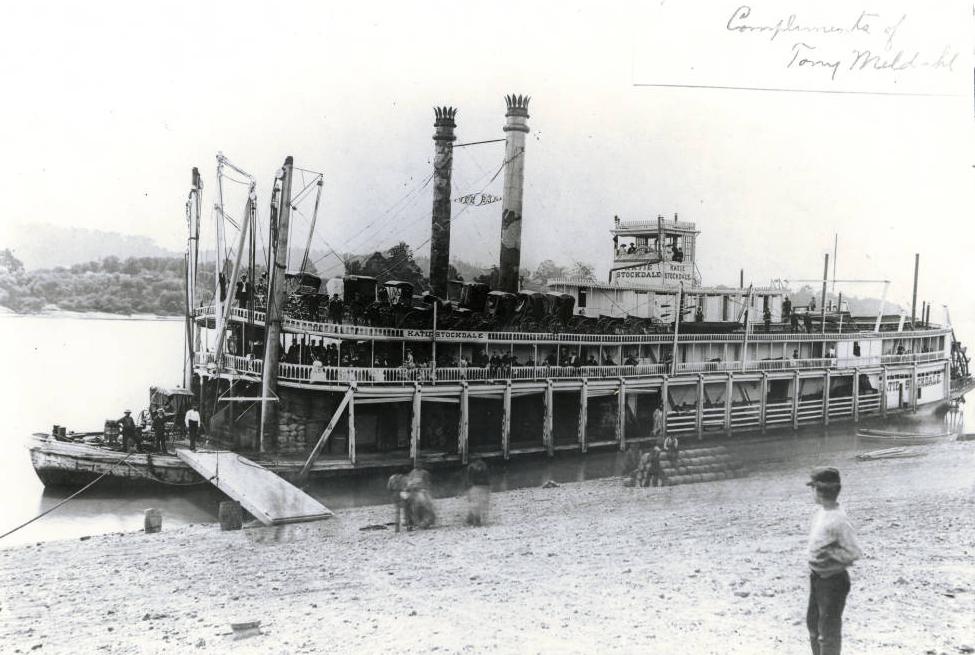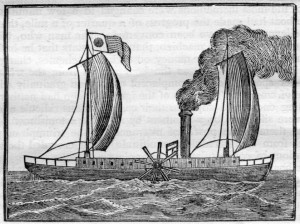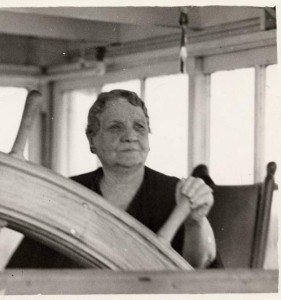“Oh We Boarded the Boat on the Breast of the River So Wide”

The 19th century is characterized by rapid expansion across the continent, facilitated by new, convenient forms of travel. Stagecoaches and other conveyances powered by horses were still in use and continued to be so into the 20th century, but with the advent of steam power, two new methods of transportation were introduced: trains and steamboats. While both were extremely impactful, steam-powered boats allowed humans to both transport goods and travel rapidly through waterways, making them one of the key developments of the 19th century.
August is an important month in the history of steamboats. On August 22, 1787, John Fitch, an inventor and former surveyor of the Northwest Territory, demonstrated the first successful steamboat run for members of the U.S. Constitutional Convention when he piloted his ship, the Perseverance, along the Delaware River. Four years later, on August 26, 1791, Fitch was awarded a U.S. patent for his design. Unfortunately for Fitch, the Patent Office granted patents to other steamboat designers on the same day, putting a halt to Fitch’s efforts to build a monopoly. As a consequence, Fitch lost his investors and was unable to continue in the U.S. steamboat industry. Attempts to establish himself in France and England were unsuccessful, as well.

Thirty years after Fitch’s successful demonstration, Robert Fulton built upon Fitch’s designs and became the first person to operate the first commercially-successful steamboat. Leaving port in New York City on August 17, he navigated his boat along the Hudson River at a speed of five miles per hour, a speed that was unheard of in water travel up to that point. Two days later, he reached his destination in Albany, New York, only to make the return trip the next day at the same rapid pace.
The steamboat, as previously stated, went on to become one of the most important inventions of the century. For Ohioans, it facilitated the move from a subsistence economy to one of commercial growth and prosperity. Ohio Memory features a number of items related to the steamboat and its history. Many depictions, both photographs and sketches, can be found there, as can records relating to the construction and purchase of The General Pike, a steamboat that operated between Cincinnati and Louisville, Kentucky, between 1824 and 1827. A portrait of Captain J. Cass Mason is also available for viewing; Mason captained the S.S. Sultana, which exploded on the Mississippi River in April 1865, resulting in the deaths of over 1,700 Civil War soldiers and making it the worst maritime disaster in U.S. history. Documents related to transportation – a directory that includes listings on both steamboats and railroads, and a legal guide to travel by steamboat, stagecoach, and railroad – can be viewed in Ohio Memory’s collections, as well.

Photographs of the Delta Queen, which traveled on the Ohio River in Washington County, are also available through Ohio Memory. The Delta Queen, a ship in the Greene Line Fleet, began sailing in 1927 and inspired the song “The Delta Queen Waltz,” a lyric from which has been used as a title for this blog post. Captain Mary Greene, who co-founded the Greene Line Fleet with her husband, Captain Gordon C. Greene, was the only female steamboat captain in Ohio during the period in which the Delta Queen sailed and, in fact, died on the steamboat in 1949. The Delta Queen is now on the National Register of Historic Places and is docked in Chattanooga, Tennessee, where it serves as a floating hotel. Senators Sherrod Brown and Rob Portman, both of Ohio, have sponsored Senate Bill 1717, which could potentially allow the Delta Queen to again serve as an overnight passenger vessel.
Perhaps this year, before cold weather sets in, you’ll choose to take a ride on a steamboat yourself. A number of commercial entities still operate ships along the Ohio River, offering dinner cruises, sightseeing trips, and so on. It is a good mix of modern convenience and history, and a great way to reach back in time and have an experience similar to that of your ancestors.
Thank you to Shannon Kupfer, Digital/Tangible Media Cataloger at theState Library of Ohio, for this week’s post!



Leave a Reply
You must be logged in to post a comment.